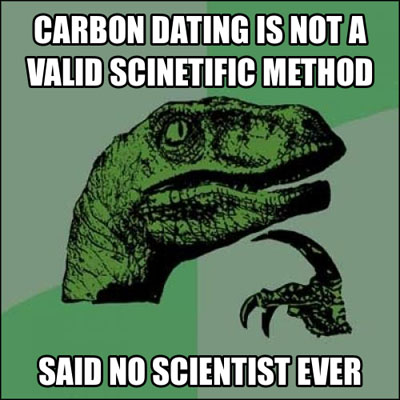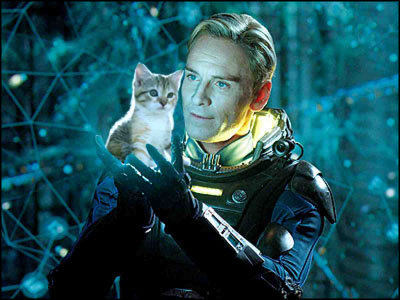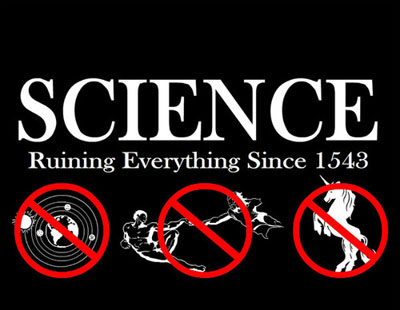Hollywood's Dating Habits: A Quick Education On Geochronology
The brilliant and exuberantly tenacious Phil Broughton is a health physicist, radiation safety educator, and the proprietor/ranter-in-chief of Funranium Labs. It’s a joy to publish his edifying, hilarious essay concerning Hollywood expository narratives as they pertain to… TEH SCIENCE! Illustrated with LULZ from across the world wide interwubz, arbitrarily selected by yours truly. Haha! Sorry, Phil. (No I’m not.) But seriously, Phil is a tremendously gregarious and charming font of knowledge, so feel free to poke him about coffee, nuclear weapons, beer, history, urban exploring, science “or any of the myriad useless facts bubbling about” in his brainmeats at [email protected]. Yay, Phil! ~Mer

Hollywood, we need to talk about your dating habits. In particular, how important it is to have a reference to verify ages before you get in trouble. No, I’m not talking about the hypersexualization of 12 year old girls trying to pass for 18. Nor am I talking about the 60-somethings trying to pass for 18 as well. That is a totally separate headshaking situation.
I would like to blame the movie Prometheus for this rant, but it’s hardly the only guilty party, just the one that finally made me snap. Hollywood, you don’t understand how carbon dating works, that there are other dating methods that sometimes work better, and that the true (unattainable) goal is to find the perfect point of reference to scale them all against. But underlying all of that is a body of scientific work and assumptions that you’ve conveniently ignored in the interest of “character driven plot”. But I have news for you: your characters and your plot make less sense when you take these shortcuts. And when you do this, people become confused as to what science and state of the art technology actually are, to the point that we have to deprogram juries and judges of the CSI Effect in capital punishment trials because Reality. Doesn’t. Work. Like. That.
You have science advisers. You ignore them at your peril. To quote Atomic Robo’s Brian Clevinger, “What’s particularly frustrating is that it takes so little effort to find the intersection between plausible science and your fiction such that the audience will go along with everything.” [DISCLOSURE: I have on occasion fielded questions from the Atomic Robo team, because Brian didn’t want the ultrascience in their scripts to sound like this.]

I’m here to help though. I’m giving you this quick primer on dating methodology, and the humorous ways they fail, for free. Of course, you get what you paid for.

We need to start by discussing cosmic bombardment. No, not “Nuke ‘em from orbit” Ripley-style, although I like the way your mind works, but rather the continuous rain of high energy particles blasting from The Great Beyond. By far the biggest source is our own sun, but that just because it’s so close. But we also have all our neighboring suns of the Milky Way, many of which are much larger and energetic than ours, and the monstrous galactic core belching stripped nuclei at relativistic speeds at us. Oh, then there’s the entire rest of the universe, supernovae, black holes and all, sending nuclei (mostly hydrogen & helium) at us at 99.999% of the speed of light, exploding in particle physics collisions with our atmosphere. The atomic fragments of this are still energetic to have a half dozen more of these collisions. This is what is known as the “cosmic ray air shower”. NOTE: at no point in the process do you create the Fantastic Four.
The particles generated by the cosmic rays can interact with the stable nuclei of the atmosphere to create new radioactive isotopes. Radioactive carbon-14 (AKA C-14), a popular isotope for dating organic materials, is generated by interacting stable nitrogen-14 in the air with a stray cosmogenic neutron. Cosmic ray bombardment of Earth does vary with latitude and the Earth’s magnetic field but due to atmospheric and water mixing, the ratio of radioactive C-14 to plain old stable C-12 is considered to be constant through in the environment. When an organism dies, no new C-14 is taken into its tissues and it starts to radioactively decay away. We can date thus things based on the changing C-14/C-12 ratio in the sample, relative to the half-life of C-14 (5712 years).

It is worth noting that C-14 is only one of Planet Earth’s many, many naturally occurring radionuclides; some have been here since the solar system coalesced, known as the primordial radionuclides, and others are constantly being created like C-14. There are other isotopes that we can, and do, use for radiometric dating but carbon is what is most useful for dating organic matter…
Carbon dating is not perfect. First, you need to calibrate the carbon “clock”. We’ve done this by comparing the carbon ratios in organic matter that we are pretty sure of the age of, such as tree rings or the growth rate of lichens. In particular, we tie specific events we know the date of, like volcanic eruptions in the historical record, and a particularly ashy tree ring. Unfortunately, we have few trees older than ~6000 years and, wow, recoded history with decent dates is utter crap until very recently.
Second, your ratio is only as good as your ability to detect and get statistically significant counts of the beta radiation from the decay of C-14. The amount of C-14 in the environment is minuscule, hard to detect, and it doesn’t get any easier as it progressively decays away in your sample. After about ten half-lives (~60000 years for C-14), we in the radiation detection game declare a radioactive isotope to be effectively gone. Really good mass spectrometry equipment can see beyond that, but the error bars on the measurements get progressively larger as you have less and less material to work with.

For these reasons, carbon dating is best used within the last 6000 years or so and gets progressively less accurate the further back you go. Beyond 60000 years, your dating is more or less useless. If anyone tells you they carbon dated something and got a date older than 60000 years, you are allowed to call bullshit on them or you should closely examine their method and decide if you need to award them the Nobel prize.
This should go without saying, but carbon dating is useless on something that wasn’t organic material to begin with. If you want to be really, really picky you could point out that limestone and calcite, both being calcium carbonate, were originally teeny tiny organisms’ shells so they’re organic material, right? I would give you the finger for being a smartass, albeit a correct one. However, it tends to take more than 50000 years to create a limestone deposit. Sure, I can go hit the tops of coral reefs for samples but I don’t have to drill very deep on the reef to find coral too old to accurately date.

Let’s list some of the basic underlying assumptions of C-14 dating techniques:
- A living thing has the same concentration of C-14 in it as everything else in the world, right up until the moment it dies.
- C-14 concentrations are the same everywhere on Earth and always have been the same.
- C-14 is being created in the atmosphere at a constant rate by a cosmic ray bombardment that has always been the same.
- Cosmic ray bombardment is the only source of C-14 production.
- We have a Known C-14 reference point in time to calculate against calibrated to our calendar.
When someone gives you such absolutes and unquestioned assumptions, you should know that you’re in trouble. That is to say, it is rife with opportunities for the advancement of human knowledge but someone may have a bad time learning it.
To seemingly completely change gears on you, My Lovely Assistant found this article regarding the oddity of the Dry Valleys near McMurdo in Antarctica. I would like to bring your attention about two thirds of the way down to the picture which should be labeled “The Most Important Seal Carcass EVAR.” “Why is this most important seal carcass”, I hear you ask, “Do you have the brain worms again?” No, I don’t but let me explain myself. It is important for two reasons:
- It is a good example of the danger of doing science and not questioning your assumptions before sharing your results.
- It is used as a basis of support for Young Earth Creationism (YEC) that is less shaky than the idiocy of carbon dating dinosaur bones and I want you to be able to call bullshit on it.

Back to Antarctica…
Once upon a time, down in the Dry Valleys, there was a researcher had been passing by this seal corpse every day and decided “Dammit, I want to know how long that mummy’s been there” and took a sample for dating. The corpse read as being about 10000 years old. This was somewhat mind-blowing as the specific seal carcass was a modern seal. The problem cropped up when they dated a bit of seal from a recently collected sample to help calibrate the carbon dating “clock” for the local area. The fresh sample, from a living seal that unhappily flopped away, dated as being 2000 years old. Uh oh…
Sharing these results, this was immediately touted as a refutation of carbon dating, and thus all science that might suggest an older Earth, by the YEC believers. A simultaneous contradictory thought accepting carbon dating commonly held by YEC is that carbon dating of dinosaur bones shows them to fall in the last 10000 years. They generally fail to discuss the likely contamination in the course of sample collection (say, perhaps, the plaster…) and that DINOSAUR BONES ARE FUCKING ROCKS, NOT ORGANIC SAMPLES.

[ASIDE: To be fair, we do have methods to date rocks (e.g. K/Ar or Nd/Sm ratio techniques) that make use of those primordial radionuclides with half-lives on the billion year scale, but their dating errors often exceed the existence of all hominids. Bishop Usher’s calculation for the age of the Earth would be very much lost in the noise.]
Scientists, on the other hand, were very puzzled by the discrepancy. They repeated the experiment several more times. Except for elephant seals and orca, every time they sampled a local organism, they kept getting an anomalously old carbon date. Those exceptions were what broke the mystery; every other organism they sampled did not leave the Southern Ocean on its migration.
Imagine, if you will a place that is very cold, and isolated from the global carbon cycle due to the austral circumpolar flow of air and surface water. Relative the carbon cycle, it’s an island. There is a deep flow of the cold water along the ocean floor to Antarctica, but it takes centuries to get there. The low intensity of the high angle cosmic ray bombardment on Antarctica means there is less locally produced C-14 inside of the isolated area and that air doesn’t mix much with the rest of the atmosphere. Thus, Antarctica is a naturally C-14 poor environment. Relative to the carbon dating calibration curves of the rest of the world, everything looks ancient here.
We also learned that our numbers get skewed in the vicinity of volcanoes; they’re a big CO2 carbon output from very old carbon locked in the Earth’s mantle that ends up saturating the local environment. So, while it’s great to use that nice ash layer in a tree ring to help set your chronology clock, you might not want to carbon date that specific ring when choosing your samples. Correspondingly, we figured out that we have completely screwed up carbon dating for future researchers (without creating major correction factors) by dumping huge amounts of most venerable carbon into the global cycle by burning fossil fuels.
Humanity also kind of, sort of, if you want to be picky, manufactured a bunch of C-14 through nuclear testing that we’ve blasted into the atmosphere that negates the assumption that cosmic ray bombardment is the only source of C-14. For this reason, when we do carbon dating “The Present” is defined as January 1, 1950. It’s the consensus date the scientific community could agree upon where, after that, we’d muddied the waters with nuclear blasts too much to do dating. Because I’m funny that way, the word I created to describe this is “nuclearche”, the onset of nuclear activities that are widely observable in the geologic record. Truly, we live in the Anthropocene Epoch and the pulse of interesting isotopes and their decay products will be the signpost that the geologists, anthropologists, and paleontologists of the future uplift raccoons society will use to study our times.
(I might be wrong about the raccoons. It could be crows. It pays to be nice to your future corvid overlords now.)

To bring this all back to complaining about the science of Prometheus, all of this goes out the window when you leave Earth. All those assumptions don’t hold true 100% on Earth, much less another planet. We established the primordial radionuclide dating system thanks to meteorites, which we assume (assumption 1) are made from the same uniform mixture of starstuff (assumption 2) that condensed into the solar system. These systems might work for Mars, but you have no idea what an alien solar system’s chemical and isotopic make up is. We have no signposts for alien worlds. Sure, we could take the time to establish what the C-14 generation rate on a given planet is, but we have no frame of reference when we first get there.
THE (SPOILERY) CONCLUSION:
When the good doctors date the corpse of the Engineer’s head and body they discovered with the Magical Dating Stick of Science, they immediately come up with 2000 years. The only way that possibly makes works is if he was born and bred on Earth, made of atoms from Earth, went to LV-223 in a vessel with no cosmic ray bombardment, and then died promptly on arrival without breathing or eating much of anything on that moon.
And this all is what went rattling through my brain and distracted me from the rest of the otherwise very pretty movie. Not nearly as bad as when I stood up in the middle of The World Is Not Enough and yelled at the screen, “THEY NEVER LOOK LIKE THAT!” at Denise Richards when she introduced herself as an IAEA nuclear physicist.
But that’s a rant for another time.


November 25th, 2012 at 1:06 am
[…] An incredibly entertaining post about carbon dating […]
November 29th, 2012 at 11:34 am
Great article. I wish this was mandatory info to be taught in basic science classes. Very easy to follow as you have explained it. and enjoyable.